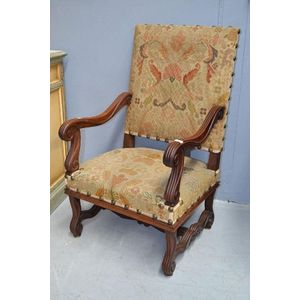Chippendale Mahogany Dining Chairs with Petite Point Upholstery
A suite of eight Chippendale style mahogany dining chairs, including two carvers with ball and claw feet, scroll molded open back splat and arms, sprung seats with recently upholstered petite point tapestry style fabric
You must be a subscriber, and be logged in to view price and dealer details.
Subscribe Now to view actual auction price for this item
When you subscribe, you have the option of setting the currency in which to display prices to $Au, $US, $NZ or Stg.
This item has been sold, and the description, image and price are for reference purposes only.
- Back Splat - The vertical or horizontal piece that joins the back to the seat, or between the two sides of the chair. The back splat stabilises and adds additional strength to the back.
- Claw Feet - Carved or cast in the shape of a lion's claw or the talons of other more fabulous beasts. They may be found on chair and table legs, supporting platform bases, and cabinets in the Classical Revival manner. Claw feet are not uncommon on Australian furniture made throughout the 1850s and 1860s, though, as with all forms of carving, the deeper and richer the claws are carved, the earlier the piece is likely to be.
- Ball and Claw Feet - Are in the shape of a rounded ball, attached to the underside of the carcase by a wooden shank. Introduced during the late 17th century and found on furniture in the William and Mary and Queen Anne style, are commonly found on cabriole legs in the manner of Thomas Chippendale, and furniture imitating the mid-18th century Rococo style. The leg terminates in a ball held by a carved lion's or bird's claw.
- Splat - The central back support between the top rail and the seat in chairs and couches. They may take a variety of forms, and run either horizontally or vertically.
- Mahogany - Mahogany is a dense, close grained red-coloured timber from the West Indies and Central America. It was first imported into Europe in the the early 18th century and its use continued through the 19th century. It was popular for furniture making because of its strength, the wide boards available, the distinctive grain on some boards, termed flame mahogany and the rich warm colour of the timber when it was polished.. The "flame" was produced where a limb grew out from the trunk of the tree, and this timber was usually sliced into veneers for feature panels on doors, backs and cornices.
Some terms used to describe mahogany relate to the country from which it originally came, such as "Cuban" mahogany, "Honduras" mahogany etc. However unless the wood has been tested the names assigned are more a selling feature, rather than a true indication of the timber's origin.
This item has been included into following indexes:
Visually similar items

A pair of Louis XIV style rectangular backed walnut armchairs, French 19th century
Sold by
in
for
You can display prices in $Au, $US, $NZ or Stg.

Antique Georgian armchair circa 1800, approx 93 cm high, 56 cm wide
Sold by
in
for
You can display prices in $Au, $US, $NZ or Stg.

Antique French 19th carved walnut and upholstered armchair
Sold by
in
for
You can display prices in $Au, $US, $NZ or Stg.

Antique French Louis XIV style armchair, approx 110 cm high, 63 cm wide
Sold by
in
for
You can display prices in $Au, $US, $NZ or Stg.
